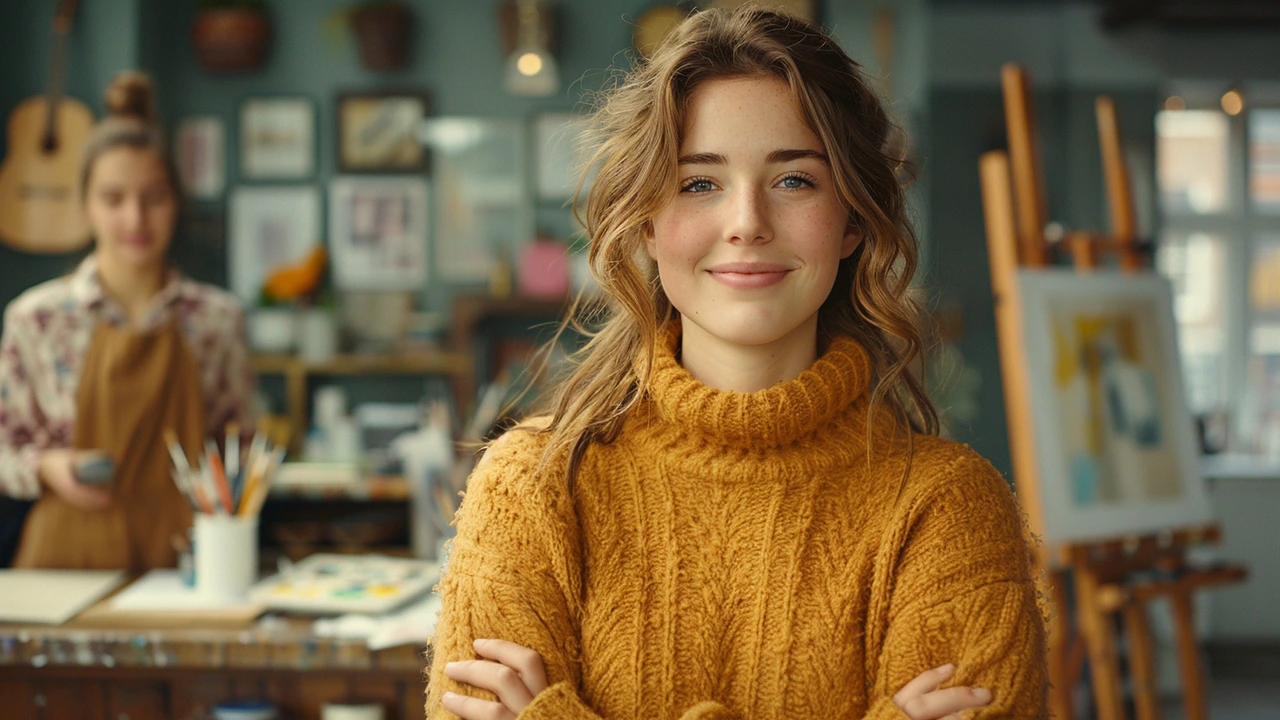Therapists have started to embrace creative arts therapies as a unique and effective approach for mental health treatment. These types of therapies use various forms of art like drawing, music, and dance to help people express their emotions and heal.
For countless individuals, traditional therapy methods can sometimes feel limiting or hard to navigate. Adding creativity to the mix opens up new avenues for expression and understanding.
Whether it's painting a picture to represent emotions or dancing to break through psychological barriers, creative arts therapies offer a diverse range of healing options that are proving valuable for therapists and clients alike.
- Understanding Creative Arts Therapies
- Different Types of Creative Arts Therapies
- Benefits of Creative Arts Therapies
- Successful Case Studies
- How to Get Started
- Choosing the Right Creative Arts Therapy for You
Understanding Creative Arts Therapies
Creative arts therapies involve the use of creative processes to help individuals address and resolve mental and emotional challenges. Unlike traditional talk therapy, these therapies use art forms such as painting, music, dance, and drama to facilitate self-expression and improve psychological well-being. The creative process itself is therapeutic, and the art produced can provide significant insights into an individual's emotional state.
One of the unique aspects of creative arts therapies is the way they allow people to express themselves in non-verbal ways. For someone who finds verbal communication challenging, creating art can be an incredibly freeing experience. Art therapy, for example, involves using visual art materials such as markers, paints, and clay. Clients create art pieces that reflect their thoughts and feelings, which are then discussed with a therapist.
"Art can permeate the very deepest part of us, where no words exist." — Eileen Miller
Music therapy, another popular form of creative arts therapy, uses music and its elements to promote emotional health. Music therapists may use active methods like playing instruments or singing, as well as passive methods such as listening to and analyzing music. Dance/movement therapy focuses on using bodily movements to express emotions, thoughts, and feelings. It encompasses activities like structured dance routines or spontaneous movements.
The History and Development of Creative Arts Therapies
The concept of using arts for healing is not new. Ancient civilizations such as the Greeks and Egyptians used various art forms for healing purposes. However, creative arts therapies as a formal mental health practice began to emerge in the mid-20th century. Psychologists and psychiatrists began recognizing the therapeutic potential of art and creativity, leading to the establishment of structured training programs and professional organizations.
| Type of Therapy | Art Form | Key Benefit |
|---|---|---|
| Art Therapy | Visual Art (painting, drawing, sculpture) | Helps with self-expression and uncovering hidden emotions |
| Music Therapy | Music (playing, listening, composing) | Aids in emotional regulation and stress relief |
| Dance/Movement Therapy | Dance, movement | Encourages physical expression of thoughts and feelings |
Today, creative arts therapies continue to grow in popularity and acceptance within the mental health community. They are used to address a wide range of issues such as trauma, anxiety, depression, and chronic illness. Many therapists value the versatility and holistic approach offered by these therapies, as they can be adapted to suit the individual needs of each client.
Different Types of Creative Arts Therapies
When we talk about creative arts therapies, we're referring to a variety of methods that utilize different art forms to promote mental well-being. Each form has its unique approach and benefits, catering to different needs and preferences. Let's delve into some of the most prominent types of creative arts therapies.
Art Therapy
Art therapy involves the use of visual arts like painting, drawing, and sculpting to explore emotions, develop self-awareness, and cope with stress. It's not about creating a masterpiece; it's about the process of making art. This form of therapy is especially beneficial for those who find it difficult to express their feelings through words.
“Art can permeate the very deepest part of us, where no words exist.” – Eileen Miller
Many individuals have found solace in art therapy, as it allows them to externalize their inner turmoil. Studies show that art therapy can reduce symptoms of anxiety and depression significantly. It's particularly useful for children and adolescents who may struggle to articulate their emotions verbally.
Music Therapy
Music therapy employs music in various forms – listening, playing instruments, singing, and composing – to improve mental and emotional health. The rhythm and melodies in music can have a profound effect on our brains, making it a powerful tool for healing. Therapists tailor sessions to the individual's needs, whether it's calming them down or energizing them.
Research has demonstrated that music therapy can significantly lower stress levels and reduce symptoms of chronic pain. It's also beneficial for people with Alzheimer's disease, as it can help improve memory and cognitive functions.
Dance/Movement Therapy
Dance or movement therapy incorporates body movement to promote emotional and physical integration. Through dance, individuals can explore their emotions, build self-confidence, and gain insights into their personal experiences. Movement helps unlock feelings that might be too difficult to verbalize.
Studies indicate that dance therapy is especially effective in treating trauma and PTSD, as the body holds onto memories and emotions in ways we might not even realize. The act of moving can be liberating and healing.
Drama Therapy
Drama therapy uses the elements of theater – storytelling, acting, and role-playing – to help individuals process and express their emotions. This form of therapy is unique in that it allows people to explore different aspects of themselves and rehearse new ways of thinking and behaving in a safe environment.
Dr. Robert Landy, a pioneer in drama therapy, states, “Through drama, we can shape and reshape our own reality.” Drama therapy has shown promise in improving social skills, emotional regulation, and resilience.
Writing Therapy
Writing therapy, often called expressive writing or journal therapy, focuses on writing as a means of processing emotions. This might involve writing essays, poems, letters, or simply keeping a journal. The act of writing can provide clarity and insight into one's thoughts and feelings.
Research by Dr. James Pennebaker has shown that expressive writing can lead to improved immune function and reduced symptoms of depression. Writing therapy is a flexible and accessible way for people to explore their inner world.
Play Therapy
Play therapy is primarily used with children and utilizes play to help them express their emotions. Through toys, games, and imaginative activities, children can convey their thoughts and feelings in a non-threatening way. Play therapy provides a safe space for children to work through their issues.
It's a valuable tool for addressing a range of issues including trauma, anxiety, and behavioral problems. The therapeutic power of play lies in its ability to connect with children on their level and speak their language.

Benefits of Creative Arts Therapies
Creative arts therapies have become a powerful tool for both therapists and clients, offering a variety of benefits that traditional methods might not provide. These therapies help people express emotions that might be hard to verbalize. This becomes especially helpful for individuals dealing with trauma, deep-seated fears, or complex emotions. When words fail, art provides a different mode of expression.
One of the key advantages is how creative arts therapies tap into our non-verbal brain regions. Studies reveal that activities like painting, music, and dance stimulate the right hemisphere of the brain, which is responsible for creativity and emotional processing. This makes these therapies particularly effective in cases where individuals have locked their emotions away. Unlocking this part of the brain can make significant strides in understanding and growth.
"Art can permeate the very deepest part of us, where no words exist." - Eileen Miller, Child Art Therapist
Another benefit is the reduction in stress and anxiety levels. Engaging in creative activities has been shown to lower levels of cortisol, the stress hormone. A session with music therapy, for example, can change our brainwave activity from a state of agitation to a more relaxed state. This has huge implications for mental health treatment, making it easier for people to find moments of peace and tranquility.
Creative arts therapies also foster a sense of community and connectedness. Group activities like collective painting projects or choir singing create a shared space where individuals can feel safe and supported. This aspect of social interaction becomes especially valuable for those who experience loneliness or social anxiety. The sense of belonging that these activities bring can be healing in itself.
A practical aspect is the versatility of application. Creative arts therapies can be used across age groups and mental health conditions. Whether it's a child dealing with ADHD, a teen grappling with depression, or an adult overcoming PTSD, there's likely an art form that can aid in their recovery. The versatility ensures that therapists can design personalized treatment plans that are both flexible and effective.
Moreover, incorporating arts into therapy can sometimes yield quicker results. Traditional talk therapy might take months before breakthroughs happen. However, creating something tangible can sometimes bring about a shift in perception more swiftly. A painting, a piece of music, or a dance performance can serve as a milestone in someone's healing journey, making the progress more visible and encouraging.
Finally, creative arts therapies offer a sense of accomplishment and improved self-esteem. Creating something through art gives individuals a tangible representation of their inner world. This act of creation can be incredibly empowering, helping people to build confidence and see self-worth in new ways. The healing journey becomes not just about dealing with problems but also about discovering new passions and strengths.
By highlighting these benefits, it's easy to see why more therapists are incorporating creative arts therapies into their practice. They offer a multi-faceted approach to healing, breaking down barriers that conventional methods may struggle with.
Successful Case Studies
Examining successful case studies can offer profound insights into the impact of creative arts therapies. One notable example involves a young woman named Sarah, who had been grappling with severe anxiety and depression. After conventional therapy methods showed minimal effects, her therapist suggested incorporating art therapy. Sarah began painting her feelings, translating her complex emotions into vivid colors and forms on canvas. Over time, this helped reduce her anxiety levels significantly and led to remarkable improvements in her mental health.
Another compelling case involves a group of veterans suffering from PTSD. These individuals participated in a music therapy program. By engaging in activities such as playing instruments and writing songs, they found a new way to communicate and process their traumatic experiences. According to a study published in the Journal of Music Therapy, veterans who participated in music therapy sessions showed a reduction in PTSD symptoms by almost 50% within six months. One participant mentioned, "Music helped me find a voice for the pain I couldn’t express with words."
Young children can also benefit from creative arts therapies. For instance, six-year-old Alex struggled with communication issues and social interaction. His school introduced a drama therapy program, where children acted out stories to express their thoughts and feelings. As Alex became more involved in the role-playing exercises, his communication skills improved dramatically, and he began forming meaningful connections with his peers. In less than a year, teachers and parents noticed a significant change in his behavior and social skills.
Additionally, a case involving elderly dementia patients at a nursing home highlights the potency of dance therapy. Participants engaged in weekly dance sessions and exhibited improvements in memory retention and physical coordination. A study by the National Institute on Aging indicates that expressive movement therapies, like dance, help in reducing agitation and boosting mood. The joy of movement and rhythm brought a new light into the lives of these elderly individuals, enhancing their overall quality of life.
Each of these cases emphasizes the personalized nature of creative arts therapies. What resonates with one person might differ for another, but the key is the freedom and tools provided to express and heal in ways conventional methods sometimes lack. These examples collectively underscore the transformative power and promise of integrating creative approaches into mental health care.

How to Get Started
Embarking on the journey of creative arts therapies can be both exciting and transformative. Whether you're a therapist looking to add these methods to your practice or someone seeking new avenues for personal healing, getting started is straightforward once you know what steps to take. Begin by exploring the different types of creative arts therapies available. Each form—be it art, music, dance, or drama therapy—carries its unique benefits and approaches. Identifying which resonates most with your needs or interests is the first crucial step. For example, if you find drawing or painting relaxing, you might lean towards art therapy. If music has always been your escape, music therapy should be on your radar.
Once you've narrowed down your choice, the next step is to seek a qualified therapist who specializes in the specific art therapy you're interested in. Qualifications and credentials matter, so look for practitioners certified by reputable organizations like the American Art Therapy Association (AATA) or the Certification Board for Music Therapists (CBMT). These certifications ensure the therapist has undergone rigorous training and meets professional standards.
"Creative arts therapies enable individuals to explore their inner landscapes in ways that words sometimes can't touch," says Dr. Cathy Malchiodi, a leading figure in art therapy.Joining a workshop or group session can also be an excellent way to dip your toes in the water. These sessions often provide a sense of community and shared experience, which can be a powerful component of the healing process. Engaging with others who are on a similar journey not only amplifies the therapeutic benefits but also offers a support network.
For those who prefer a more individualized approach, one-on-one sessions with a therapist can provide tailored guidance and focused attention. Some therapists even offer virtual sessions, making it easier to fit therapy into your schedule. It's essential to find a comfortable and private space for your sessions, whether at home or in a studio.
Dipping into literature on creative arts therapies can also arm you with valuable knowledge and insights. Books, articles, and online resources can deepen your understanding and prepare you for what to expect. Authors like Shaun McNiff and Cathy Malchiodi have written extensively on the subject and can serve as excellent starting points.
| Type of Therapy | Prominent Benefits |
|---|---|
| Art Therapy | Enhances self-expression, reduces stress. |
| Music Therapy | Improves mood, helps with emotional regulation. |
| Dance Therapy | Encourages physical activity, improves body image. |
| Drama Therapy | Boosts self-confidence, fosters creativity. |
Remember, the goal of creative arts therapy is not to produce a masterpiece but to explore and understand your inner world in a safe and supportive environment. Be open to the process and allow yourself the freedom to experiment and discover what works best for you. Over time, you'll likely find that these therapies offer profound insights and healing opportunities, enriching your life in unexpected ways.
Choosing the Right Creative Arts Therapy for You
Finding the right creative arts therapy for yourself can seem daunting, but it doesn't have to be. Each form of therapy offers unique benefits that cater to different needs and personalities. The key is to understand what resonates with you and aligns with your therapeutic goals.
Firstly, consider what kind of creative expression speaks to you. For instance, if you've always been drawn to music, music therapy might be an excellent fit. This form of therapy uses music to address emotional, cognitive, and social needs through activities such as singing, playing instruments, and listening to melodies. Research shows that music therapy can significantly reduce anxiety and improve mood.
“Art can permeate the very deepest part of us, where no words exist.” – Eileen Miller
If painting or drawing feels natural to you, then art therapy might be your best option. This therapy uses the process of creating art to explore feelings and reconcile emotional conflicts. Studies have indicated that art therapy can be particularly effective for individuals dealing with trauma, as it provides a non-verbal outlet for expressing and processing complex emotions.
Exploring Dance and Movement Therapy
For those who feel they express themselves better through physical movement, dance and movement therapy could be the ideal path. This therapy encourages individuals to use their bodies to communicate and release tension. Dance therapy is particularly beneficial for those who feel disconnected from their bodies or have difficulty articulating their feelings. Studies have found that dance therapy can improve self-esteem and body image.
When considering which therapy to choose, consulting with a professional therapist could be helpful. They can guide you based on an assessment of your needs and preferences. Some people find it beneficial to try multiple forms before settling on one that feels most effective.
Group settings are also an option. Many people find participating in group creative arts therapies to be rewarding. These settings provide social interaction and collective support, which can enhance the therapeutic experience. Whether it's a group music session or a communal art project, the sense of belonging and shared purpose can itself be healing.
Always remember that creative arts therapy is about the journey rather than the destination. There is no right or wrong way to engage in these therapies, and what matters most is how you feel throughout the process. Your therapist can adapt sessions to cater to your evolving needs, ensuring the therapy continues to benefit you.
Embarking on this path involves a willingness to explore and discover new dimensions of self-expression and healing. By choosing the right creative arts therapy, you open up new ways to understand yourself and navigate your mental health journey.





